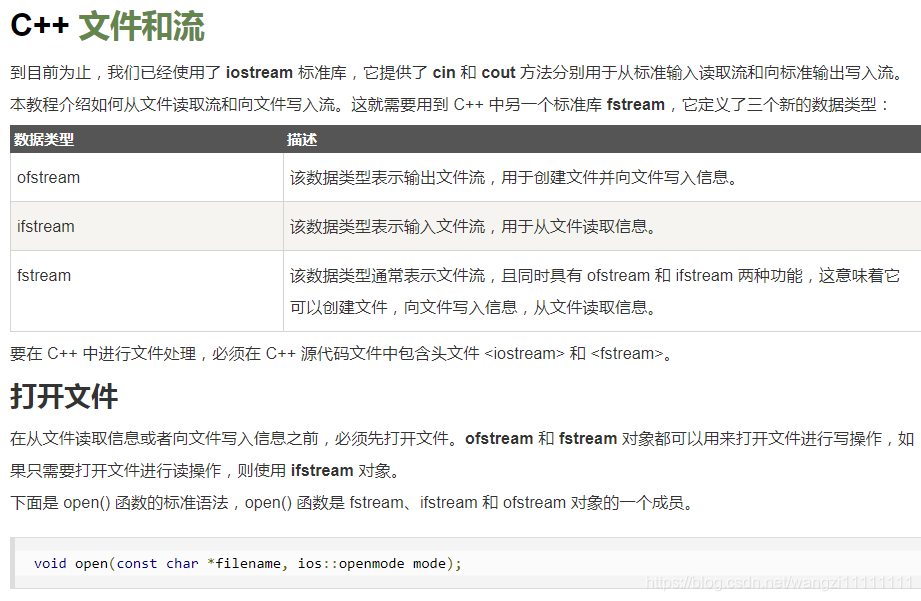文章目录
- 目录
- 1.文件和流
- 2.异常处理
- 3.动态内存
- 4.命名空间
目录
1.文件和流


注意
文件打开方式中的in和out都是相对于内存(计算机)而言的,计算机读取文件,是将数据从磁盘中的文件读入到内存中,所以用的是in
#include <fstream>
#include <iostream>
using namespace std;int main ()
{char data[100];// 以写模式打开文件ofstream outfile;outfile.open("afile.dat");cout << "Writing to the file" << endl;cout << "Enter your name: "; cin.getline(data, 100);// 向文件写入用户输入的数据outfile << data << endl;cout << "Enter your age: "; cin >> data;cin.ignore();// 再次向文件写入用户输入的数据outfile << data << endl;// 关闭打开的文件outfile.close();// 以读模式打开文件ifstream infile; infile.open("afile.dat"); cout << "Reading from the file" << endl; infile >> data; // 在屏幕上写入数据cout << data << endl;// 再次从文件读取数据,并显示它infile >> data; cout << data << endl; // 关闭打开的文件infile.close();return 0;
}
当上面的代码被编译和执行时,它会产生下列输入和输出:
$./a.out
Writing to the file
Enter your name: Zara
Enter your age: 9
Reading from the file
Zara
9
注意
流操作符也是相对于计算机而言的,计算机是可以赋值和改变的左值,在左边,所以从外部读取数据到计算机(内存中),使用的流操作符是<< ;同理,从计算机(内存中)输出到其他设备(屏幕),使用的流操作符是 >>,数据的方向是从内存到外部设备,所以箭头朝右边,非常形象。


#include "iostream"
#include "fstream"
using namespace std;//向文件内部写入数据,并将数据读出
void file_wr(void)
{char data[100];//向文件写入数据ofstream outfile;outfile.open("test.txt");cout << "Write to the file" << endl;cout << "Enter your name:" << endl;cin.getline(data, 100);outfile << data << endl;cout << "Enter your age:" << endl;cin >> data;cin.ignore();outfile << data << endl;outfile.close();//从文件读取数据ifstream infile;infile.open("test.txt");cout << "Read from the file" << endl;infile >> data;cout << data << endl;infile >> data;cout << data << endl;infile.close();
}//将数据从一文件复制到另一文件中
void file_copy(void)
{char data[100];ifstream infile;ofstream outfile;infile.open("test.txt");outfile.open("test_1.txt");cout << "copy from test.txt to test_1.txt" << endl;while (!infile.eof()){infile >> data;cout << data << endl;outfile << data << endl;}infile.close();outfile.close();
}//测试上述读写文件,与文件数据复制
int main()
{file_wr();file_copy();return 0;
}
当上面的代码被编译和执行时,它会产生下列输入和输出:
$./a.out
Writing to the file
Enter your name:
John
Enter your age:
20
Reading from the file
John
20
copy from test.txt to test_1.txt
John
20
2.异常处理



#include <iostream>
using namespace std;double division(int a, int b)
{if( b == 0 ){throw "Division by zero condition!";}return (a/b);
}int main ()
{int x = 50;int y = 0;double z = 0;try {z = division(x, y);cout << z << endl;}catch (const char* msg) {cerr << msg << endl;}return 0;
}
由于我们抛出了一个类型为 const char* 的异常,因此,当捕获该异常时,我们必须在 catch 块中使用 const char*。当上面的代码被编译和执行时,它会产生下列结果:
Division by zero condition!


3.动态内存


#include <iostream>
using namespace std;int main ()
{double* pvalue = NULL; // 初始化为 null 的指针pvalue = new double; // 为变量请求内存*pvalue = 29494.99; // 在分配的地址存储值cout << "Value of pvalue : " << *pvalue << endl;delete pvalue; // 释放内存return 0;
}

#include <iostream>
using namespace std;int main()
{int **p; int i,j; //p[4][8] //开始分配4行8列的二维数据 p = new int *[4];for(i=0;i<4;i++){p[i]=new int [8];}for(i=0; i<4; i++){for(j=0; j<8; j++){p[i][j] = j*i;}} //打印数据 for(i=0; i<4; i++){for(j=0; j<8; j++) { if(j==0) cout<<endl; cout<<p[i][j]<<"\t"; }} //开始释放申请的堆 for(i=0; i<4; i++){delete [] p[i]; }delete [] p; return 0;
}
0 0 0 0 0 0 0 0
0 1 2 3 4 5 6 7
0 2 4 6 8 10 12 14
0 3 6 9 12 15 18 21

#include <iostream>
using namespace std;class Box
{public:Box() { cout << "调用构造函数!" <<endl; }~Box() { cout << "调用析构函数!" <<endl; }
};int main( )
{Box* myBoxArray = new Box[4];delete [] myBoxArray; // 删除数组return 0;
}
如果要为一个包含四个 Box 对象的数组分配内存,构造函数将被调用 4 次,同样地,当删除这些对象时,析构函数也将被调用相同的次数(4次)。
当上面的代码被编译和执行时,它会产生下列结果:
调用构造函数!
调用构造函数!
调用构造函数!
调用构造函数!
调用析构函数!
调用析构函数!
调用析构函数!
调用析构函数!

class A
{private:char *m_cBuffer;int m_nLen;public:A(){ m_cBuffer = new char[m_nLen]; }~A() { delete [] m_cBuffer; }
};
A *a = new A[10];// 仅释放了a指针指向的全部内存空间 但是只调用了a[0]对象的析构函数 剩下的从a[1]到a[9]这9个用户自行分配的m_cBuffer对应内存空间将不能释放 从而造成内存泄漏
delete a;// 调用使用类对象的析构函数释放用户自己分配内存空间并且 释放了a指针指向的全部内存空间
delete [] a;

4.命名空间
本质上,命名空间就是定义了一个范围。

#include <iostream>
using namespace std;// 第一个命名空间
namespace first_space{void func(){cout << "Inside first_space" << endl;}
}
// 第二个命名空间
namespace second_space{void func(){cout << "Inside second_space" << endl;}
}
int main ()
{// 调用第一个命名空间中的函数first_space::func();// 调用第二个命名空间中的函数second_space::func(); return 0;
}
当上面的代码被编译和执行时,它会产生下列结果:
Inside first_space
Inside second_space

#include <iostream>
using namespace std;// 第一个命名空间
namespace first_space{void func(){cout << "Inside first_space" << endl;}
}
// 第二个命名空间
namespace second_space{void func(){cout << "Inside second_space" << endl;}
}
using namespace first_space;
int main ()
{// 调用第一个命名空间中的函数func();return 0;
}
当上面的代码被编译和执行时,它会产生下列结果:
Inside first_space
using 指令也可以用来指定命名空间中的特定项目。例如,如果您只打算使用 std 命名空间中的 cout 部分,您可以使用如下的语句:
using std::cout;

#include <iostream>
using namespace std;// 第一个命名空间
namespace first_space{void func(){cout << "Inside first_space" << endl;}// 第二个命名空间namespace second_space{void func(){cout << "Inside second_space" << endl;}}
}
using namespace first_space::second_space;
int main ()
{// 调用第二个命名空间中的函数func();return 0;
}
当上面的代码被编译和执行时,它会产生下列结果:
Inside second_space


---字符串(c++))

--(STL、标准库))
)
--(模板、预处理器、信号处理))

--(多线程、Web编程))
迭代器模式)

---栈和队列(c++))

---数组,动态内存,vector(c++))
---链表(c++))

---二叉树(c++))



)
